Resource Management at Nestle: HRM Practices and Employee Relations
VerifiedAdded on 2023/01/12
|12
|3389
|99
Report
AI Summary
This report provides a comprehensive analysis of Nestle's Human Resource Management (HRM) practices. It begins with an overview of Nestle's business, mission, purpose, and core objectives, followed by an examination of the HR function's roles and responsibilities in acquiring talented candidates. The report assesses the strengths and weaknesses of Nestle's recruitment and selection approaches, suggesting alternative methods. It then evaluates HRM practices, considering their benefits to both employers and employees, and their impact on profit and productivity. The concept of employee relations and the influence of HRM practices on decision-making are also explored. Furthermore, the report includes the design of a job specification, a sample CV, and a discussion of the candidate selection process. Finally, the report evaluates the application of employment legislation within the organization.
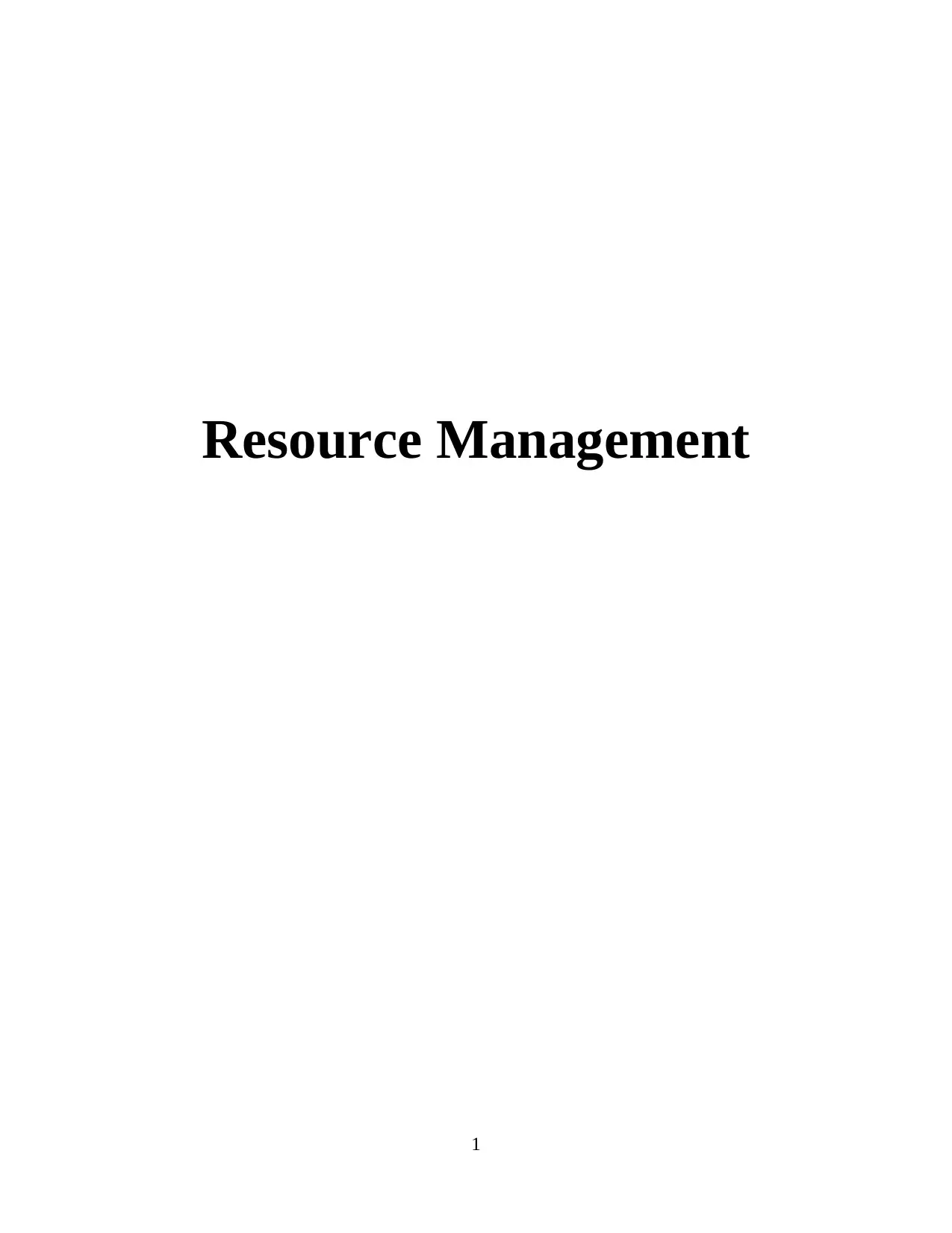
Resource Management
1
1
Paraphrase This Document
Need a fresh take? Get an instant paraphrase of this document with our AI Paraphraser
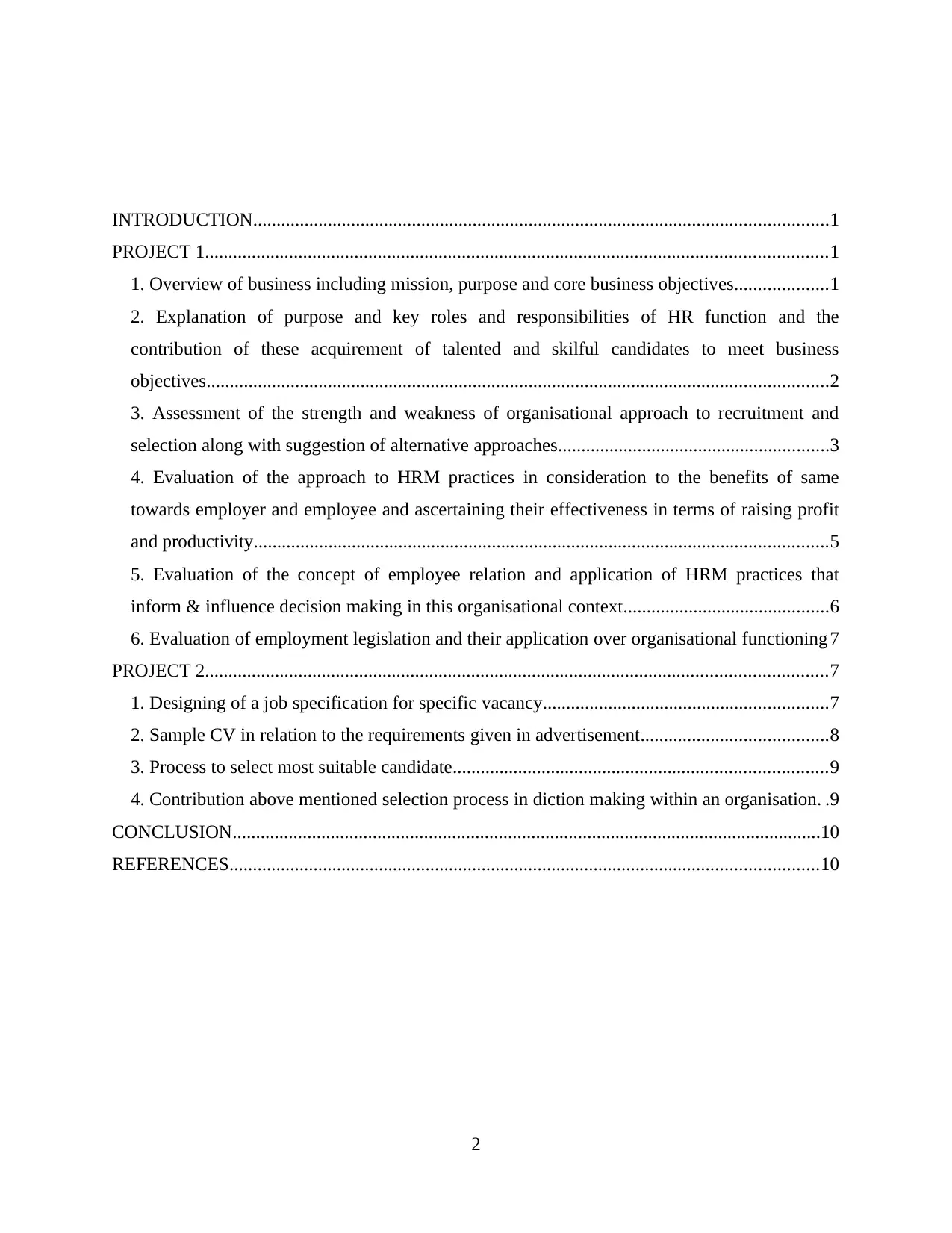
INTRODUCTION...........................................................................................................................1
PROJECT 1.....................................................................................................................................1
1. Overview of business including mission, purpose and core business objectives....................1
2. Explanation of purpose and key roles and responsibilities of HR function and the
contribution of these acquirement of talented and skilful candidates to meet business
objectives.....................................................................................................................................2
3. Assessment of the strength and weakness of organisational approach to recruitment and
selection along with suggestion of alternative approaches..........................................................3
4. Evaluation of the approach to HRM practices in consideration to the benefits of same
towards employer and employee and ascertaining their effectiveness in terms of raising profit
and productivity...........................................................................................................................5
5. Evaluation of the concept of employee relation and application of HRM practices that
inform & influence decision making in this organisational context............................................6
6. Evaluation of employment legislation and their application over organisational functioning 7
PROJECT 2.....................................................................................................................................7
1. Designing of a job specification for specific vacancy.............................................................7
2. Sample CV in relation to the requirements given in advertisement........................................8
3. Process to select most suitable candidate................................................................................9
4. Contribution above mentioned selection process in diction making within an organisation. .9
CONCLUSION..............................................................................................................................10
REFERENCES..............................................................................................................................10
2
PROJECT 1.....................................................................................................................................1
1. Overview of business including mission, purpose and core business objectives....................1
2. Explanation of purpose and key roles and responsibilities of HR function and the
contribution of these acquirement of talented and skilful candidates to meet business
objectives.....................................................................................................................................2
3. Assessment of the strength and weakness of organisational approach to recruitment and
selection along with suggestion of alternative approaches..........................................................3
4. Evaluation of the approach to HRM practices in consideration to the benefits of same
towards employer and employee and ascertaining their effectiveness in terms of raising profit
and productivity...........................................................................................................................5
5. Evaluation of the concept of employee relation and application of HRM practices that
inform & influence decision making in this organisational context............................................6
6. Evaluation of employment legislation and their application over organisational functioning 7
PROJECT 2.....................................................................................................................................7
1. Designing of a job specification for specific vacancy.............................................................7
2. Sample CV in relation to the requirements given in advertisement........................................8
3. Process to select most suitable candidate................................................................................9
4. Contribution above mentioned selection process in diction making within an organisation. .9
CONCLUSION..............................................................................................................................10
REFERENCES..............................................................................................................................10
2
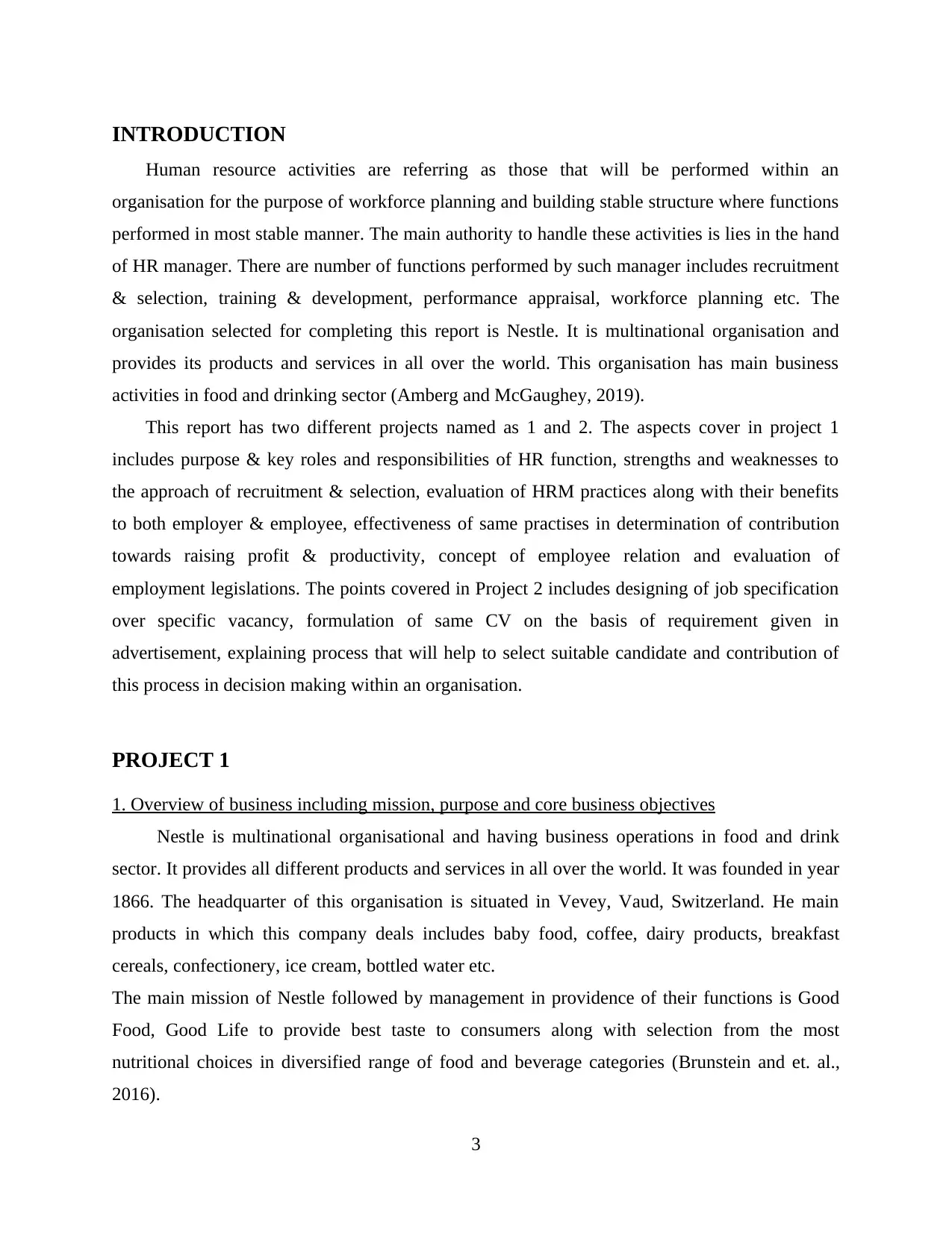
INTRODUCTION
Human resource activities are referring as those that will be performed within an
organisation for the purpose of workforce planning and building stable structure where functions
performed in most stable manner. The main authority to handle these activities is lies in the hand
of HR manager. There are number of functions performed by such manager includes recruitment
& selection, training & development, performance appraisal, workforce planning etc. The
organisation selected for completing this report is Nestle. It is multinational organisation and
provides its products and services in all over the world. This organisation has main business
activities in food and drinking sector (Amberg and McGaughey, 2019).
This report has two different projects named as 1 and 2. The aspects cover in project 1
includes purpose & key roles and responsibilities of HR function, strengths and weaknesses to
the approach of recruitment & selection, evaluation of HRM practices along with their benefits
to both employer & employee, effectiveness of same practises in determination of contribution
towards raising profit & productivity, concept of employee relation and evaluation of
employment legislations. The points covered in Project 2 includes designing of job specification
over specific vacancy, formulation of same CV on the basis of requirement given in
advertisement, explaining process that will help to select suitable candidate and contribution of
this process in decision making within an organisation.
PROJECT 1
1. Overview of business including mission, purpose and core business objectives
Nestle is multinational organisational and having business operations in food and drink
sector. It provides all different products and services in all over the world. It was founded in year
1866. The headquarter of this organisation is situated in Vevey, Vaud, Switzerland. He main
products in which this company deals includes baby food, coffee, dairy products, breakfast
cereals, confectionery, ice cream, bottled water etc.
The main mission of Nestle followed by management in providence of their functions is Good
Food, Good Life to provide best taste to consumers along with selection from the most
nutritional choices in diversified range of food and beverage categories (Brunstein and et. al.,
2016).
3
Human resource activities are referring as those that will be performed within an
organisation for the purpose of workforce planning and building stable structure where functions
performed in most stable manner. The main authority to handle these activities is lies in the hand
of HR manager. There are number of functions performed by such manager includes recruitment
& selection, training & development, performance appraisal, workforce planning etc. The
organisation selected for completing this report is Nestle. It is multinational organisation and
provides its products and services in all over the world. This organisation has main business
activities in food and drinking sector (Amberg and McGaughey, 2019).
This report has two different projects named as 1 and 2. The aspects cover in project 1
includes purpose & key roles and responsibilities of HR function, strengths and weaknesses to
the approach of recruitment & selection, evaluation of HRM practices along with their benefits
to both employer & employee, effectiveness of same practises in determination of contribution
towards raising profit & productivity, concept of employee relation and evaluation of
employment legislations. The points covered in Project 2 includes designing of job specification
over specific vacancy, formulation of same CV on the basis of requirement given in
advertisement, explaining process that will help to select suitable candidate and contribution of
this process in decision making within an organisation.
PROJECT 1
1. Overview of business including mission, purpose and core business objectives
Nestle is multinational organisational and having business operations in food and drink
sector. It provides all different products and services in all over the world. It was founded in year
1866. The headquarter of this organisation is situated in Vevey, Vaud, Switzerland. He main
products in which this company deals includes baby food, coffee, dairy products, breakfast
cereals, confectionery, ice cream, bottled water etc.
The main mission of Nestle followed by management in providence of their functions is Good
Food, Good Life to provide best taste to consumers along with selection from the most
nutritional choices in diversified range of food and beverage categories (Brunstein and et. al.,
2016).
3
⊘ This is a preview!⊘
Do you want full access?
Subscribe today to unlock all pages.

Trusted by 1+ million students worldwide
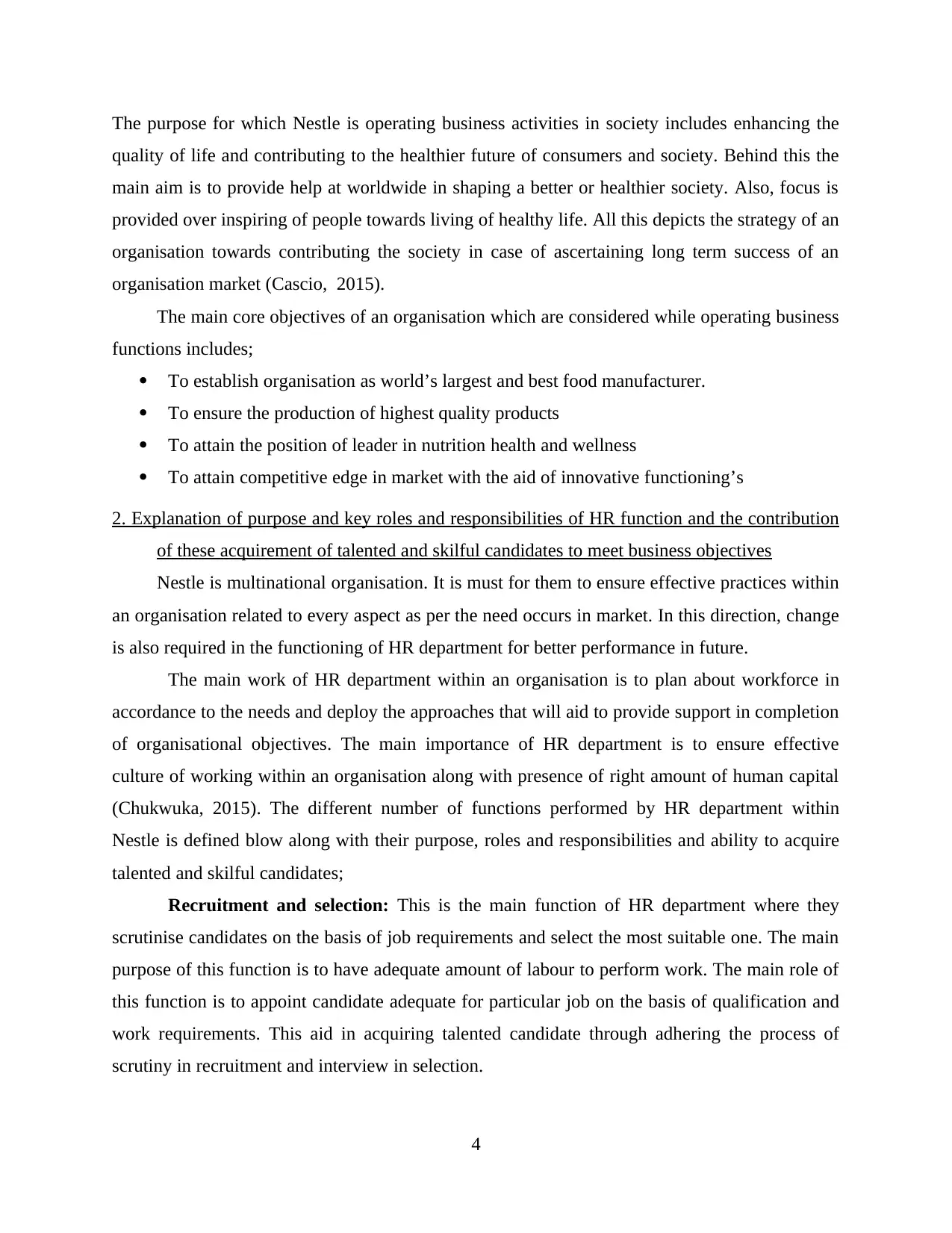
The purpose for which Nestle is operating business activities in society includes enhancing the
quality of life and contributing to the healthier future of consumers and society. Behind this the
main aim is to provide help at worldwide in shaping a better or healthier society. Also, focus is
provided over inspiring of people towards living of healthy life. All this depicts the strategy of an
organisation towards contributing the society in case of ascertaining long term success of an
organisation market (Cascio, 2015).
The main core objectives of an organisation which are considered while operating business
functions includes;
To establish organisation as world’s largest and best food manufacturer.
To ensure the production of highest quality products
To attain the position of leader in nutrition health and wellness
To attain competitive edge in market with the aid of innovative functioning’s
2. Explanation of purpose and key roles and responsibilities of HR function and the contribution
of these acquirement of talented and skilful candidates to meet business objectives
Nestle is multinational organisation. It is must for them to ensure effective practices within
an organisation related to every aspect as per the need occurs in market. In this direction, change
is also required in the functioning of HR department for better performance in future.
The main work of HR department within an organisation is to plan about workforce in
accordance to the needs and deploy the approaches that will aid to provide support in completion
of organisational objectives. The main importance of HR department is to ensure effective
culture of working within an organisation along with presence of right amount of human capital
(Chukwuka, 2015). The different number of functions performed by HR department within
Nestle is defined blow along with their purpose, roles and responsibilities and ability to acquire
talented and skilful candidates;
Recruitment and selection: This is the main function of HR department where they
scrutinise candidates on the basis of job requirements and select the most suitable one. The main
purpose of this function is to have adequate amount of labour to perform work. The main role of
this function is to appoint candidate adequate for particular job on the basis of qualification and
work requirements. This aid in acquiring talented candidate through adhering the process of
scrutiny in recruitment and interview in selection.
4
quality of life and contributing to the healthier future of consumers and society. Behind this the
main aim is to provide help at worldwide in shaping a better or healthier society. Also, focus is
provided over inspiring of people towards living of healthy life. All this depicts the strategy of an
organisation towards contributing the society in case of ascertaining long term success of an
organisation market (Cascio, 2015).
The main core objectives of an organisation which are considered while operating business
functions includes;
To establish organisation as world’s largest and best food manufacturer.
To ensure the production of highest quality products
To attain the position of leader in nutrition health and wellness
To attain competitive edge in market with the aid of innovative functioning’s
2. Explanation of purpose and key roles and responsibilities of HR function and the contribution
of these acquirement of talented and skilful candidates to meet business objectives
Nestle is multinational organisation. It is must for them to ensure effective practices within
an organisation related to every aspect as per the need occurs in market. In this direction, change
is also required in the functioning of HR department for better performance in future.
The main work of HR department within an organisation is to plan about workforce in
accordance to the needs and deploy the approaches that will aid to provide support in completion
of organisational objectives. The main importance of HR department is to ensure effective
culture of working within an organisation along with presence of right amount of human capital
(Chukwuka, 2015). The different number of functions performed by HR department within
Nestle is defined blow along with their purpose, roles and responsibilities and ability to acquire
talented and skilful candidates;
Recruitment and selection: This is the main function of HR department where they
scrutinise candidates on the basis of job requirements and select the most suitable one. The main
purpose of this function is to have adequate amount of labour to perform work. The main role of
this function is to appoint candidate adequate for particular job on the basis of qualification and
work requirements. This aid in acquiring talented candidate through adhering the process of
scrutiny in recruitment and interview in selection.
4
Paraphrase This Document
Need a fresh take? Get an instant paraphrase of this document with our AI Paraphraser
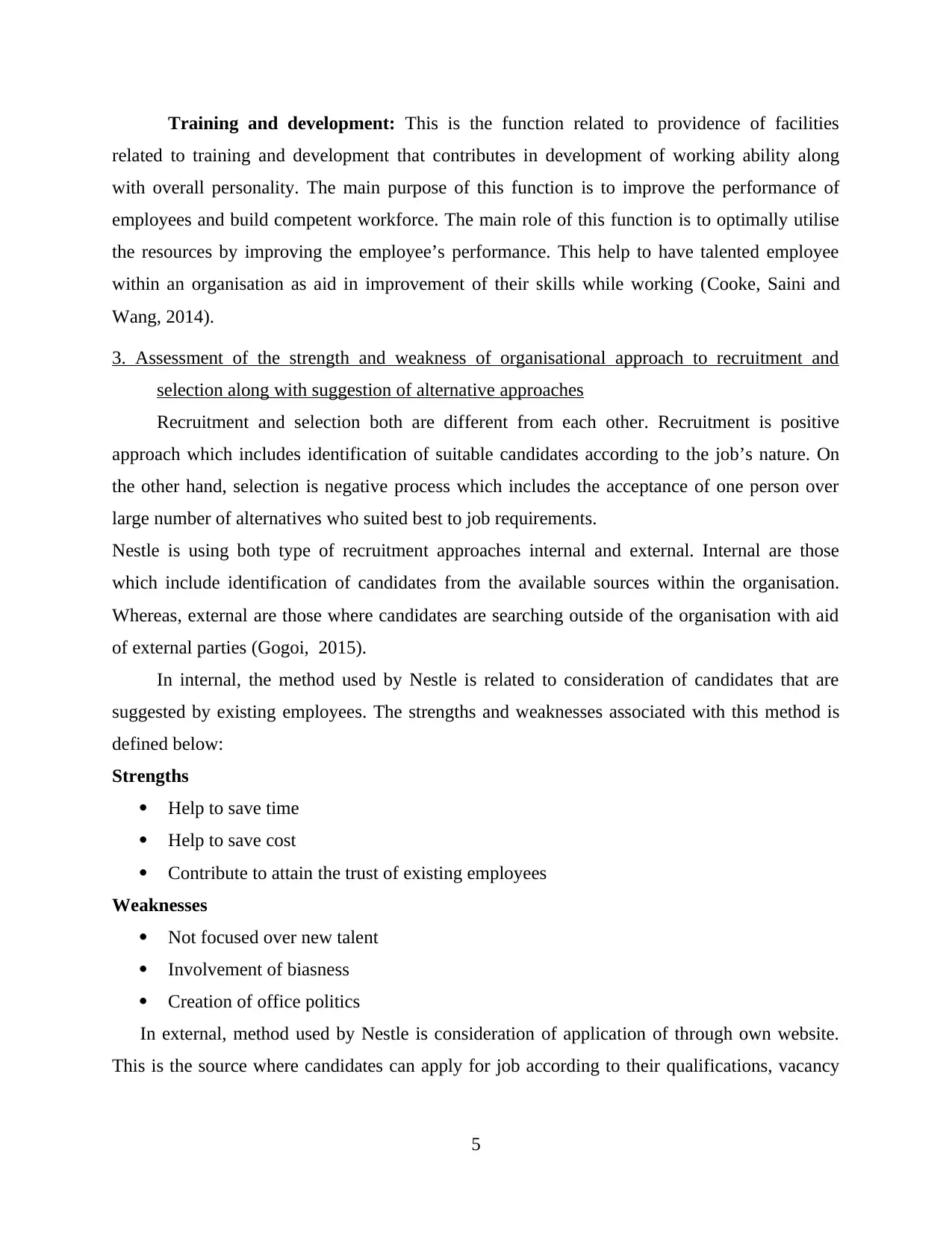
Training and development: This is the function related to providence of facilities
related to training and development that contributes in development of working ability along
with overall personality. The main purpose of this function is to improve the performance of
employees and build competent workforce. The main role of this function is to optimally utilise
the resources by improving the employee’s performance. This help to have talented employee
within an organisation as aid in improvement of their skills while working (Cooke, Saini and
Wang, 2014).
3. Assessment of the strength and weakness of organisational approach to recruitment and
selection along with suggestion of alternative approaches
Recruitment and selection both are different from each other. Recruitment is positive
approach which includes identification of suitable candidates according to the job’s nature. On
the other hand, selection is negative process which includes the acceptance of one person over
large number of alternatives who suited best to job requirements.
Nestle is using both type of recruitment approaches internal and external. Internal are those
which include identification of candidates from the available sources within the organisation.
Whereas, external are those where candidates are searching outside of the organisation with aid
of external parties (Gogoi, 2015).
In internal, the method used by Nestle is related to consideration of candidates that are
suggested by existing employees. The strengths and weaknesses associated with this method is
defined below:
Strengths
Help to save time
Help to save cost
Contribute to attain the trust of existing employees
Weaknesses
Not focused over new talent
Involvement of biasness
Creation of office politics
In external, method used by Nestle is consideration of application of through own website.
This is the source where candidates can apply for job according to their qualifications, vacancy
5
related to training and development that contributes in development of working ability along
with overall personality. The main purpose of this function is to improve the performance of
employees and build competent workforce. The main role of this function is to optimally utilise
the resources by improving the employee’s performance. This help to have talented employee
within an organisation as aid in improvement of their skills while working (Cooke, Saini and
Wang, 2014).
3. Assessment of the strength and weakness of organisational approach to recruitment and
selection along with suggestion of alternative approaches
Recruitment and selection both are different from each other. Recruitment is positive
approach which includes identification of suitable candidates according to the job’s nature. On
the other hand, selection is negative process which includes the acceptance of one person over
large number of alternatives who suited best to job requirements.
Nestle is using both type of recruitment approaches internal and external. Internal are those
which include identification of candidates from the available sources within the organisation.
Whereas, external are those where candidates are searching outside of the organisation with aid
of external parties (Gogoi, 2015).
In internal, the method used by Nestle is related to consideration of candidates that are
suggested by existing employees. The strengths and weaknesses associated with this method is
defined below:
Strengths
Help to save time
Help to save cost
Contribute to attain the trust of existing employees
Weaknesses
Not focused over new talent
Involvement of biasness
Creation of office politics
In external, method used by Nestle is consideration of application of through own website.
This is the source where candidates can apply for job according to their qualifications, vacancy
5
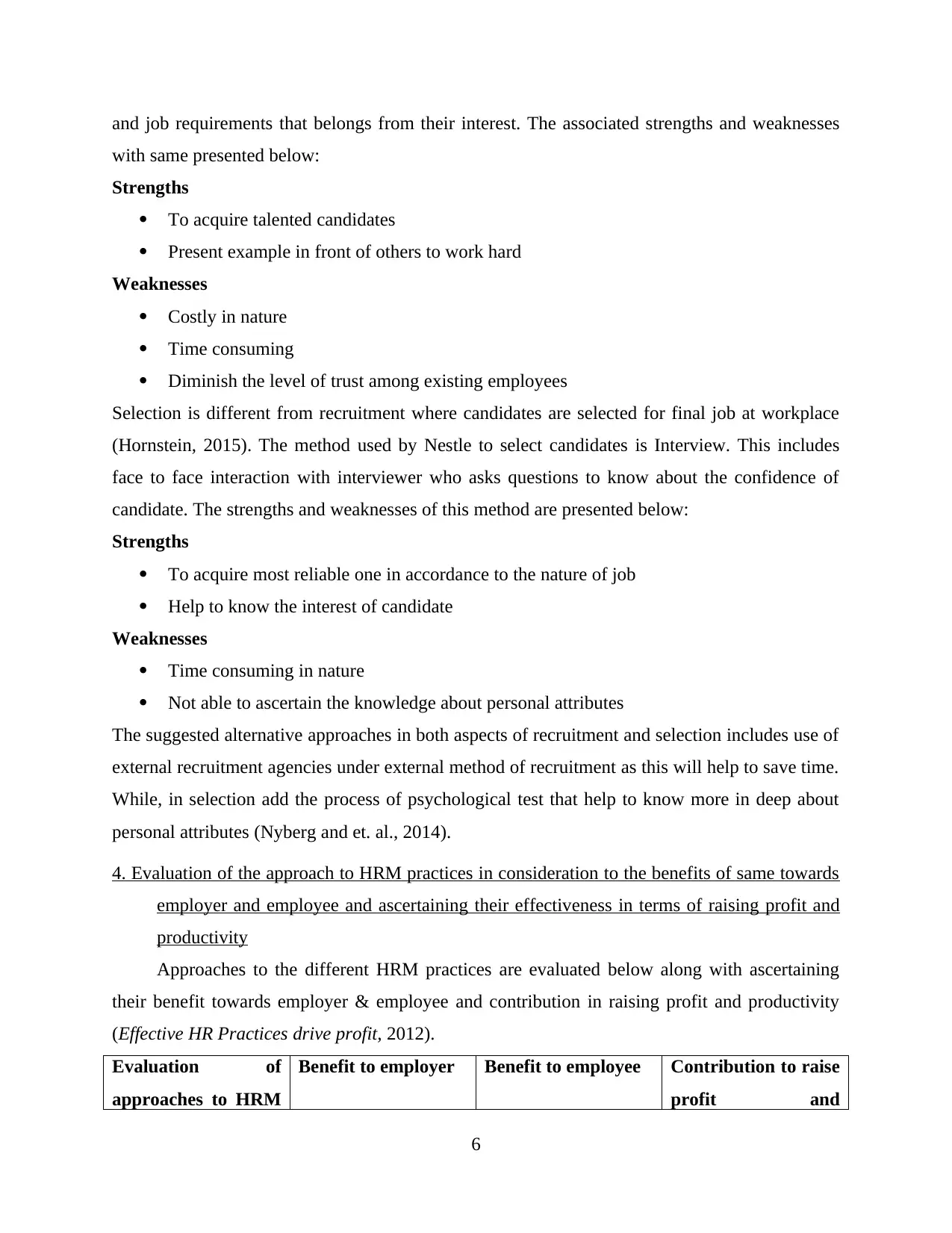
and job requirements that belongs from their interest. The associated strengths and weaknesses
with same presented below:
Strengths
To acquire talented candidates
Present example in front of others to work hard
Weaknesses
Costly in nature
Time consuming
Diminish the level of trust among existing employees
Selection is different from recruitment where candidates are selected for final job at workplace
(Hornstein, 2015). The method used by Nestle to select candidates is Interview. This includes
face to face interaction with interviewer who asks questions to know about the confidence of
candidate. The strengths and weaknesses of this method are presented below:
Strengths
To acquire most reliable one in accordance to the nature of job
Help to know the interest of candidate
Weaknesses
Time consuming in nature
Not able to ascertain the knowledge about personal attributes
The suggested alternative approaches in both aspects of recruitment and selection includes use of
external recruitment agencies under external method of recruitment as this will help to save time.
While, in selection add the process of psychological test that help to know more in deep about
personal attributes (Nyberg and et. al., 2014).
4. Evaluation of the approach to HRM practices in consideration to the benefits of same towards
employer and employee and ascertaining their effectiveness in terms of raising profit and
productivity
Approaches to the different HRM practices are evaluated below along with ascertaining
their benefit towards employer & employee and contribution in raising profit and productivity
(Effective HR Practices drive profit, 2012).
Evaluation of
approaches to HRM
Benefit to employer Benefit to employee Contribution to raise
profit and
6
with same presented below:
Strengths
To acquire talented candidates
Present example in front of others to work hard
Weaknesses
Costly in nature
Time consuming
Diminish the level of trust among existing employees
Selection is different from recruitment where candidates are selected for final job at workplace
(Hornstein, 2015). The method used by Nestle to select candidates is Interview. This includes
face to face interaction with interviewer who asks questions to know about the confidence of
candidate. The strengths and weaknesses of this method are presented below:
Strengths
To acquire most reliable one in accordance to the nature of job
Help to know the interest of candidate
Weaknesses
Time consuming in nature
Not able to ascertain the knowledge about personal attributes
The suggested alternative approaches in both aspects of recruitment and selection includes use of
external recruitment agencies under external method of recruitment as this will help to save time.
While, in selection add the process of psychological test that help to know more in deep about
personal attributes (Nyberg and et. al., 2014).
4. Evaluation of the approach to HRM practices in consideration to the benefits of same towards
employer and employee and ascertaining their effectiveness in terms of raising profit and
productivity
Approaches to the different HRM practices are evaluated below along with ascertaining
their benefit towards employer & employee and contribution in raising profit and productivity
(Effective HR Practices drive profit, 2012).
Evaluation of
approaches to HRM
Benefit to employer Benefit to employee Contribution to raise
profit and
6
⊘ This is a preview!⊘
Do you want full access?
Subscribe today to unlock all pages.

Trusted by 1+ million students worldwide
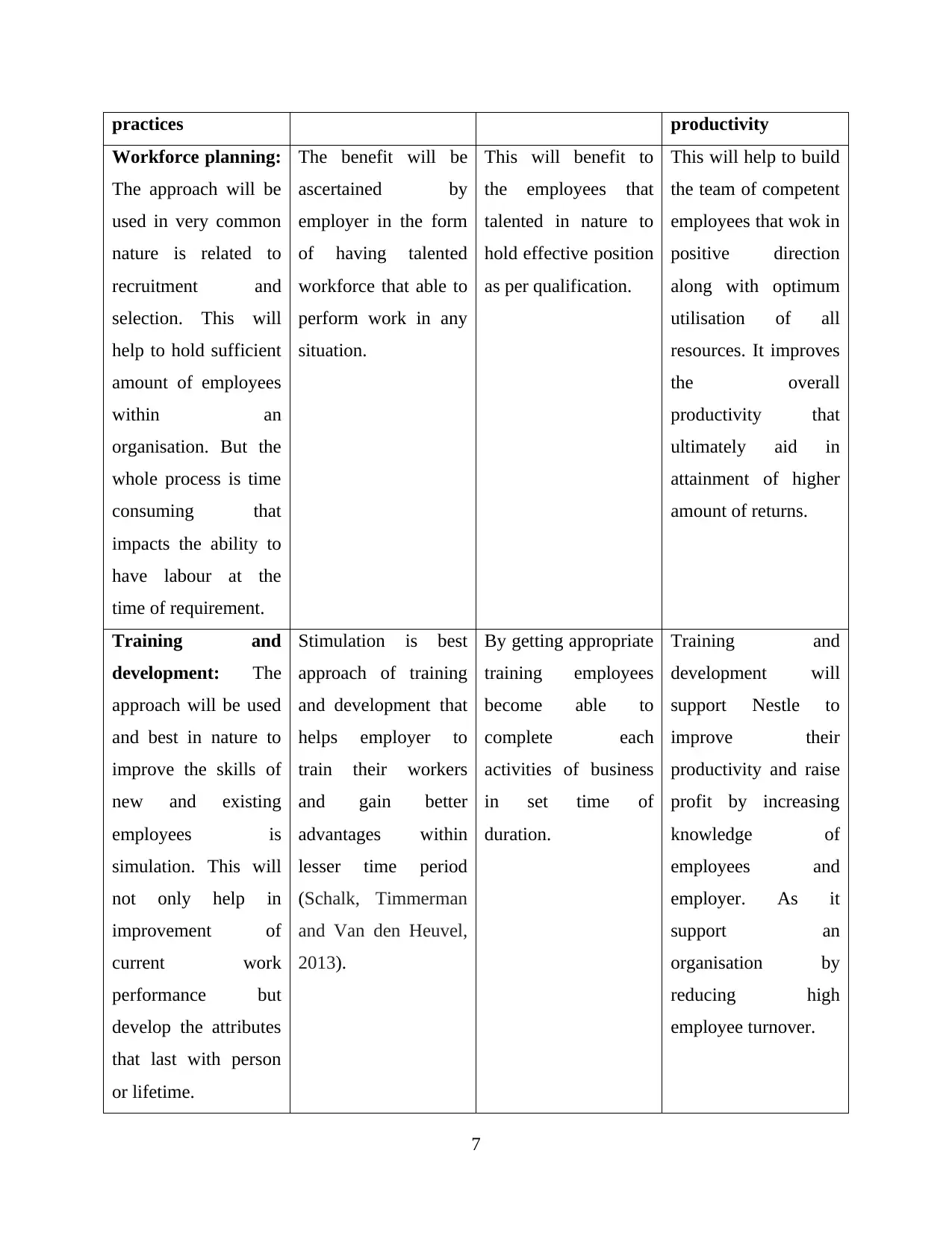
practices productivity
Workforce planning:
The approach will be
used in very common
nature is related to
recruitment and
selection. This will
help to hold sufficient
amount of employees
within an
organisation. But the
whole process is time
consuming that
impacts the ability to
have labour at the
time of requirement.
The benefit will be
ascertained by
employer in the form
of having talented
workforce that able to
perform work in any
situation.
This will benefit to
the employees that
talented in nature to
hold effective position
as per qualification.
This will help to build
the team of competent
employees that wok in
positive direction
along with optimum
utilisation of all
resources. It improves
the overall
productivity that
ultimately aid in
attainment of higher
amount of returns.
Training and
development: The
approach will be used
and best in nature to
improve the skills of
new and existing
employees is
simulation. This will
not only help in
improvement of
current work
performance but
develop the attributes
that last with person
or lifetime.
Stimulation is best
approach of training
and development that
helps employer to
train their workers
and gain better
advantages within
lesser time period
(Schalk, Timmerman
and Van den Heuvel,
2013).
By getting appropriate
training employees
become able to
complete each
activities of business
in set time of
duration.
Training and
development will
support Nestle to
improve their
productivity and raise
profit by increasing
knowledge of
employees and
employer. As it
support an
organisation by
reducing high
employee turnover.
7
Workforce planning:
The approach will be
used in very common
nature is related to
recruitment and
selection. This will
help to hold sufficient
amount of employees
within an
organisation. But the
whole process is time
consuming that
impacts the ability to
have labour at the
time of requirement.
The benefit will be
ascertained by
employer in the form
of having talented
workforce that able to
perform work in any
situation.
This will benefit to
the employees that
talented in nature to
hold effective position
as per qualification.
This will help to build
the team of competent
employees that wok in
positive direction
along with optimum
utilisation of all
resources. It improves
the overall
productivity that
ultimately aid in
attainment of higher
amount of returns.
Training and
development: The
approach will be used
and best in nature to
improve the skills of
new and existing
employees is
simulation. This will
not only help in
improvement of
current work
performance but
develop the attributes
that last with person
or lifetime.
Stimulation is best
approach of training
and development that
helps employer to
train their workers
and gain better
advantages within
lesser time period
(Schalk, Timmerman
and Van den Heuvel,
2013).
By getting appropriate
training employees
become able to
complete each
activities of business
in set time of
duration.
Training and
development will
support Nestle to
improve their
productivity and raise
profit by increasing
knowledge of
employees and
employer. As it
support an
organisation by
reducing high
employee turnover.
7
Paraphrase This Document
Need a fresh take? Get an instant paraphrase of this document with our AI Paraphraser
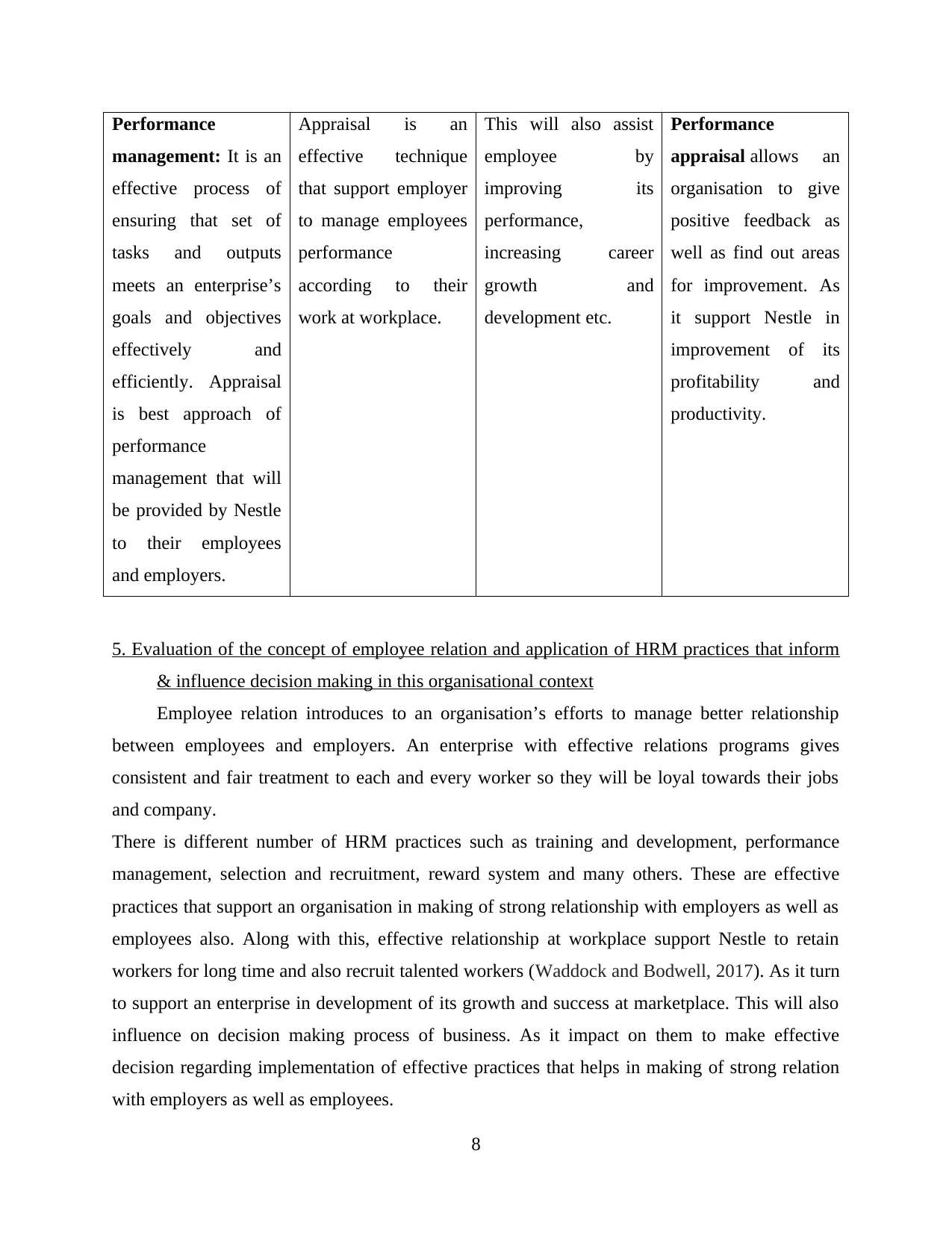
Performance
management: It is an
effective process of
ensuring that set of
tasks and outputs
meets an enterprise’s
goals and objectives
effectively and
efficiently. Appraisal
is best approach of
performance
management that will
be provided by Nestle
to their employees
and employers.
Appraisal is an
effective technique
that support employer
to manage employees
performance
according to their
work at workplace.
This will also assist
employee by
improving its
performance,
increasing career
growth and
development etc.
Performance
appraisal allows an
organisation to give
positive feedback as
well as find out areas
for improvement. As
it support Nestle in
improvement of its
profitability and
productivity.
5. Evaluation of the concept of employee relation and application of HRM practices that inform
& influence decision making in this organisational context
Employee relation introduces to an organisation’s efforts to manage better relationship
between employees and employers. An enterprise with effective relations programs gives
consistent and fair treatment to each and every worker so they will be loyal towards their jobs
and company.
There is different number of HRM practices such as training and development, performance
management, selection and recruitment, reward system and many others. These are effective
practices that support an organisation in making of strong relationship with employers as well as
employees also. Along with this, effective relationship at workplace support Nestle to retain
workers for long time and also recruit talented workers (Waddock and Bodwell, 2017). As it turn
to support an enterprise in development of its growth and success at marketplace. This will also
influence on decision making process of business. As it impact on them to make effective
decision regarding implementation of effective practices that helps in making of strong relation
with employers as well as employees.
8
management: It is an
effective process of
ensuring that set of
tasks and outputs
meets an enterprise’s
goals and objectives
effectively and
efficiently. Appraisal
is best approach of
performance
management that will
be provided by Nestle
to their employees
and employers.
Appraisal is an
effective technique
that support employer
to manage employees
performance
according to their
work at workplace.
This will also assist
employee by
improving its
performance,
increasing career
growth and
development etc.
Performance
appraisal allows an
organisation to give
positive feedback as
well as find out areas
for improvement. As
it support Nestle in
improvement of its
profitability and
productivity.
5. Evaluation of the concept of employee relation and application of HRM practices that inform
& influence decision making in this organisational context
Employee relation introduces to an organisation’s efforts to manage better relationship
between employees and employers. An enterprise with effective relations programs gives
consistent and fair treatment to each and every worker so they will be loyal towards their jobs
and company.
There is different number of HRM practices such as training and development, performance
management, selection and recruitment, reward system and many others. These are effective
practices that support an organisation in making of strong relationship with employers as well as
employees also. Along with this, effective relationship at workplace support Nestle to retain
workers for long time and also recruit talented workers (Waddock and Bodwell, 2017). As it turn
to support an enterprise in development of its growth and success at marketplace. This will also
influence on decision making process of business. As it impact on them to make effective
decision regarding implementation of effective practices that helps in making of strong relation
with employers as well as employees.
8
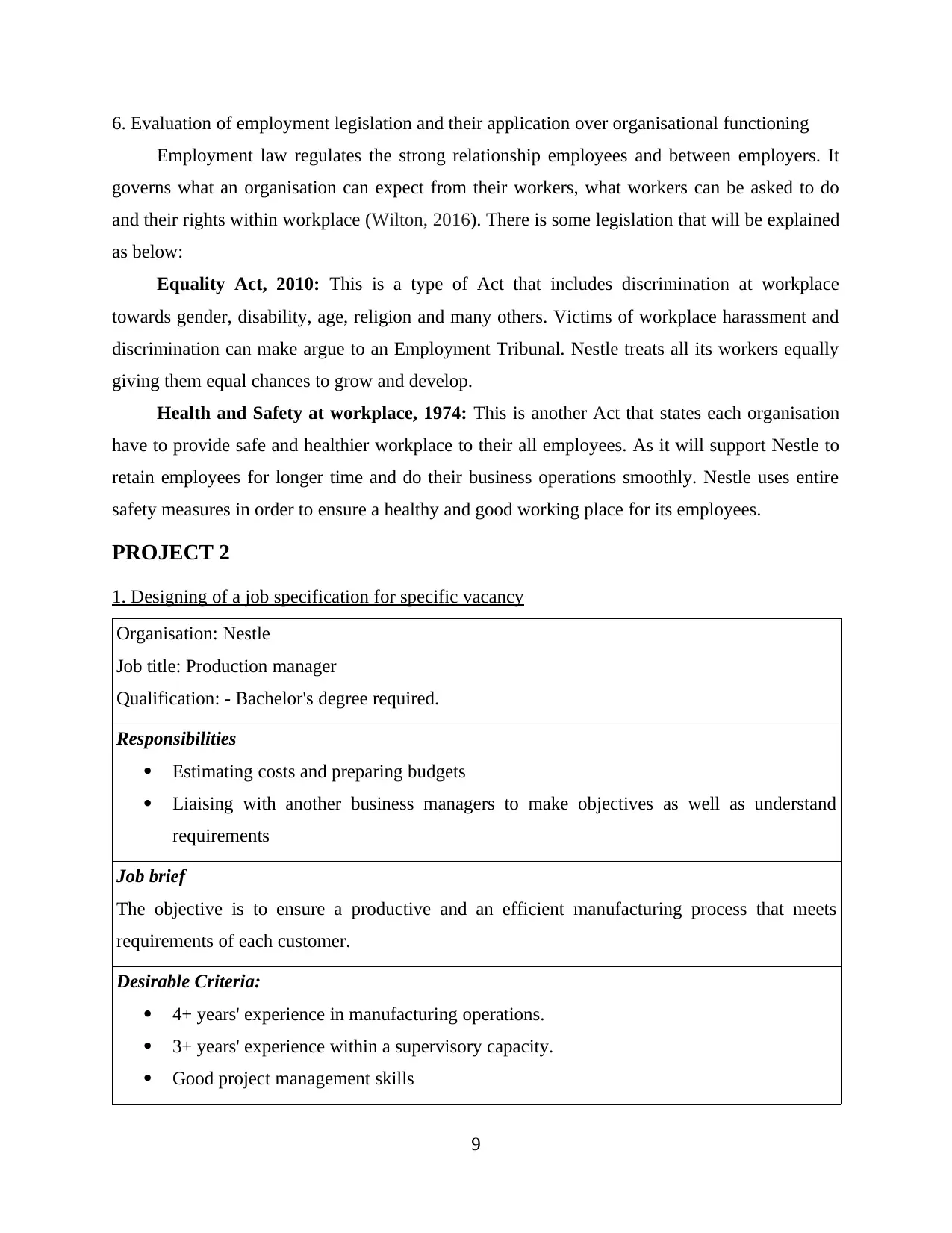
6. Evaluation of employment legislation and their application over organisational functioning
Employment law regulates the strong relationship employees and between employers. It
governs what an organisation can expect from their workers, what workers can be asked to do
and their rights within workplace (Wilton, 2016). There is some legislation that will be explained
as below:
Equality Act, 2010: This is a type of Act that includes discrimination at workplace
towards gender, disability, age, religion and many others. Victims of workplace harassment and
discrimination can make argue to an Employment Tribunal. Nestle treats all its workers equally
giving them equal chances to grow and develop.
Health and Safety at workplace, 1974: This is another Act that states each organisation
have to provide safe and healthier workplace to their all employees. As it will support Nestle to
retain employees for longer time and do their business operations smoothly. Nestle uses entire
safety measures in order to ensure a healthy and good working place for its employees.
PROJECT 2
1. Designing of a job specification for specific vacancy
Organisation: Nestle
Job title: Production manager
Qualification: - Bachelor's degree required.
Responsibilities
Estimating costs and preparing budgets
Liaising with another business managers to make objectives as well as understand
requirements
Job brief
The objective is to ensure a productive and an efficient manufacturing process that meets
requirements of each customer.
Desirable Criteria:
4+ years' experience in manufacturing operations.
3+ years' experience within a supervisory capacity.
Good project management skills
9
Employment law regulates the strong relationship employees and between employers. It
governs what an organisation can expect from their workers, what workers can be asked to do
and their rights within workplace (Wilton, 2016). There is some legislation that will be explained
as below:
Equality Act, 2010: This is a type of Act that includes discrimination at workplace
towards gender, disability, age, religion and many others. Victims of workplace harassment and
discrimination can make argue to an Employment Tribunal. Nestle treats all its workers equally
giving them equal chances to grow and develop.
Health and Safety at workplace, 1974: This is another Act that states each organisation
have to provide safe and healthier workplace to their all employees. As it will support Nestle to
retain employees for longer time and do their business operations smoothly. Nestle uses entire
safety measures in order to ensure a healthy and good working place for its employees.
PROJECT 2
1. Designing of a job specification for specific vacancy
Organisation: Nestle
Job title: Production manager
Qualification: - Bachelor's degree required.
Responsibilities
Estimating costs and preparing budgets
Liaising with another business managers to make objectives as well as understand
requirements
Job brief
The objective is to ensure a productive and an efficient manufacturing process that meets
requirements of each customer.
Desirable Criteria:
4+ years' experience in manufacturing operations.
3+ years' experience within a supervisory capacity.
Good project management skills
9
⊘ This is a preview!⊘
Do you want full access?
Subscribe today to unlock all pages.

Trusted by 1+ million students worldwide
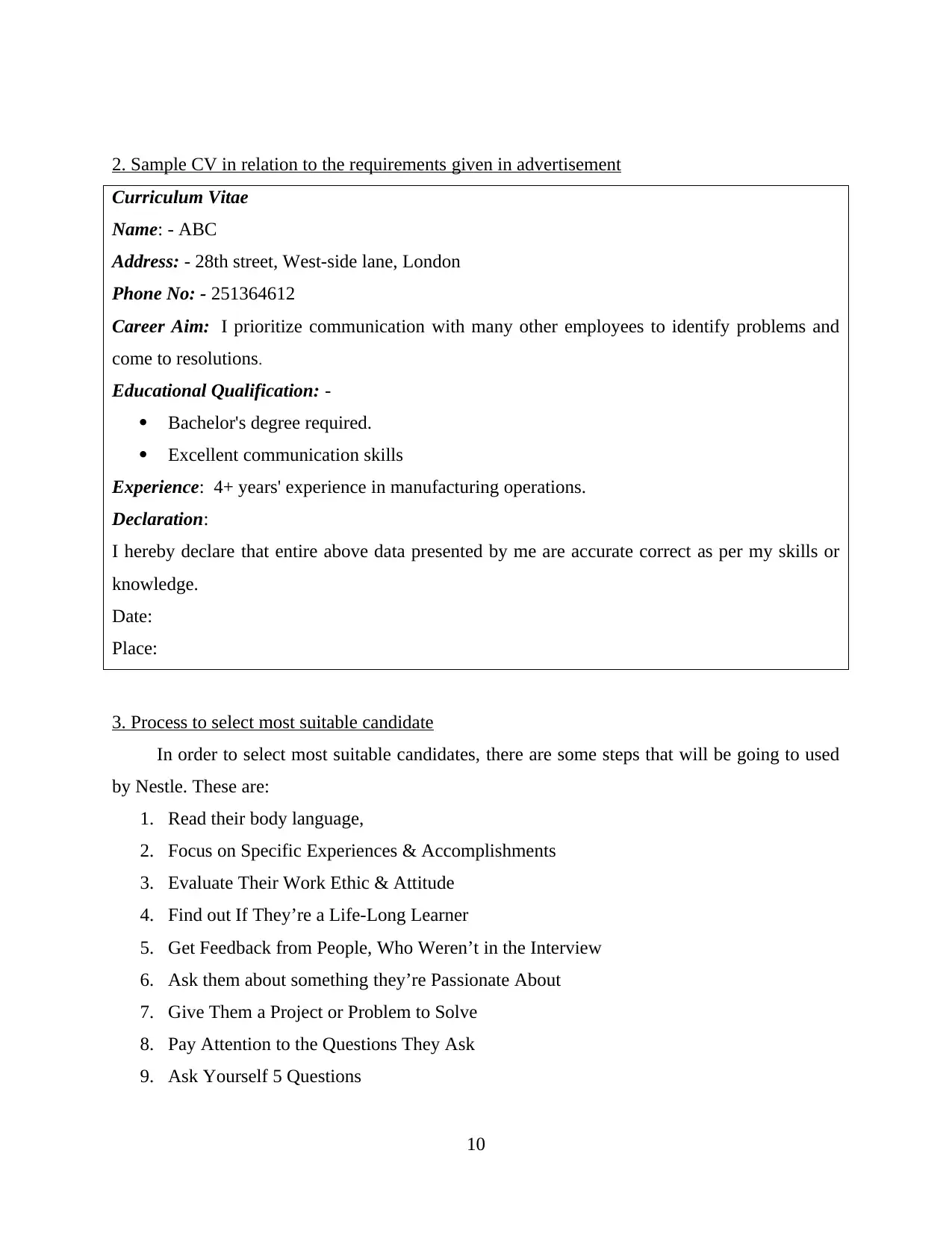
2. Sample CV in relation to the requirements given in advertisement
Curriculum Vitae
Name: - ABC
Address: - 28th street, West-side lane, London
Phone No: - 251364612
Career Aim: I prioritize communication with many other employees to identify problems and
come to resolutions.
Educational Qualification: -
Bachelor's degree required.
Excellent communication skills
Experience: 4+ years' experience in manufacturing operations.
Declaration:
I hereby declare that entire above data presented by me are accurate correct as per my skills or
knowledge.
Date:
Place:
3. Process to select most suitable candidate
In order to select most suitable candidates, there are some steps that will be going to used
by Nestle. These are:
1. Read their body language,
2. Focus on Specific Experiences & Accomplishments
3. Evaluate Their Work Ethic & Attitude
4. Find out If They’re a Life-Long Learner
5. Get Feedback from People, Who Weren’t in the Interview
6. Ask them about something they’re Passionate About
7. Give Them a Project or Problem to Solve
8. Pay Attention to the Questions They Ask
9. Ask Yourself 5 Questions
10
Curriculum Vitae
Name: - ABC
Address: - 28th street, West-side lane, London
Phone No: - 251364612
Career Aim: I prioritize communication with many other employees to identify problems and
come to resolutions.
Educational Qualification: -
Bachelor's degree required.
Excellent communication skills
Experience: 4+ years' experience in manufacturing operations.
Declaration:
I hereby declare that entire above data presented by me are accurate correct as per my skills or
knowledge.
Date:
Place:
3. Process to select most suitable candidate
In order to select most suitable candidates, there are some steps that will be going to used
by Nestle. These are:
1. Read their body language,
2. Focus on Specific Experiences & Accomplishments
3. Evaluate Their Work Ethic & Attitude
4. Find out If They’re a Life-Long Learner
5. Get Feedback from People, Who Weren’t in the Interview
6. Ask them about something they’re Passionate About
7. Give Them a Project or Problem to Solve
8. Pay Attention to the Questions They Ask
9. Ask Yourself 5 Questions
10
Paraphrase This Document
Need a fresh take? Get an instant paraphrase of this document with our AI Paraphraser
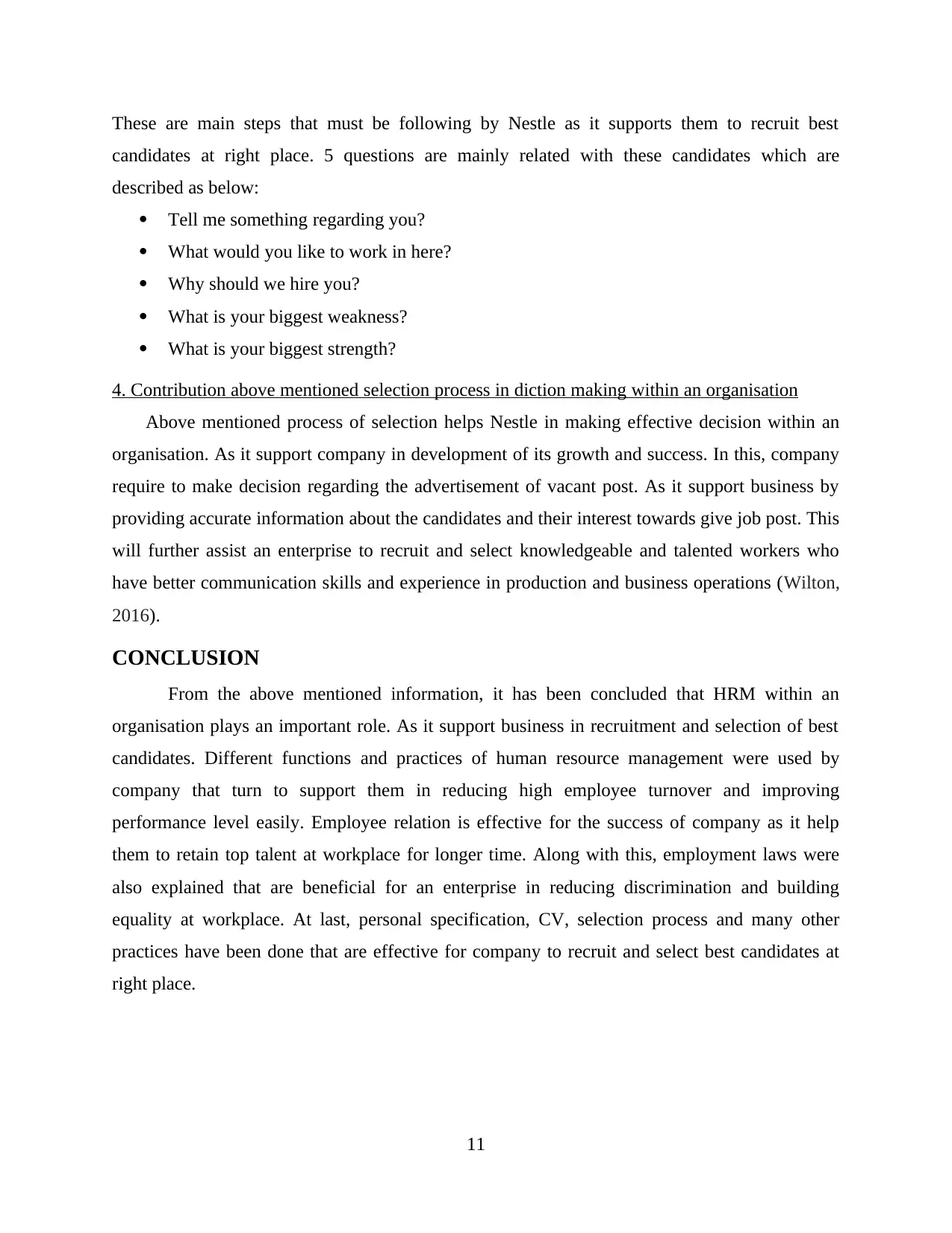
These are main steps that must be following by Nestle as it supports them to recruit best
candidates at right place. 5 questions are mainly related with these candidates which are
described as below:
Tell me something regarding you?
What would you like to work in here?
Why should we hire you?
What is your biggest weakness?
What is your biggest strength?
4. Contribution above mentioned selection process in diction making within an organisation
Above mentioned process of selection helps Nestle in making effective decision within an
organisation. As it support company in development of its growth and success. In this, company
require to make decision regarding the advertisement of vacant post. As it support business by
providing accurate information about the candidates and their interest towards give job post. This
will further assist an enterprise to recruit and select knowledgeable and talented workers who
have better communication skills and experience in production and business operations (Wilton,
2016).
CONCLUSION
From the above mentioned information, it has been concluded that HRM within an
organisation plays an important role. As it support business in recruitment and selection of best
candidates. Different functions and practices of human resource management were used by
company that turn to support them in reducing high employee turnover and improving
performance level easily. Employee relation is effective for the success of company as it help
them to retain top talent at workplace for longer time. Along with this, employment laws were
also explained that are beneficial for an enterprise in reducing discrimination and building
equality at workplace. At last, personal specification, CV, selection process and many other
practices have been done that are effective for company to recruit and select best candidates at
right place.
11
candidates at right place. 5 questions are mainly related with these candidates which are
described as below:
Tell me something regarding you?
What would you like to work in here?
Why should we hire you?
What is your biggest weakness?
What is your biggest strength?
4. Contribution above mentioned selection process in diction making within an organisation
Above mentioned process of selection helps Nestle in making effective decision within an
organisation. As it support company in development of its growth and success. In this, company
require to make decision regarding the advertisement of vacant post. As it support business by
providing accurate information about the candidates and their interest towards give job post. This
will further assist an enterprise to recruit and select knowledgeable and talented workers who
have better communication skills and experience in production and business operations (Wilton,
2016).
CONCLUSION
From the above mentioned information, it has been concluded that HRM within an
organisation plays an important role. As it support business in recruitment and selection of best
candidates. Different functions and practices of human resource management were used by
company that turn to support them in reducing high employee turnover and improving
performance level easily. Employee relation is effective for the success of company as it help
them to retain top talent at workplace for longer time. Along with this, employment laws were
also explained that are beneficial for an enterprise in reducing discrimination and building
equality at workplace. At last, personal specification, CV, selection process and many other
practices have been done that are effective for company to recruit and select best candidates at
right place.
11
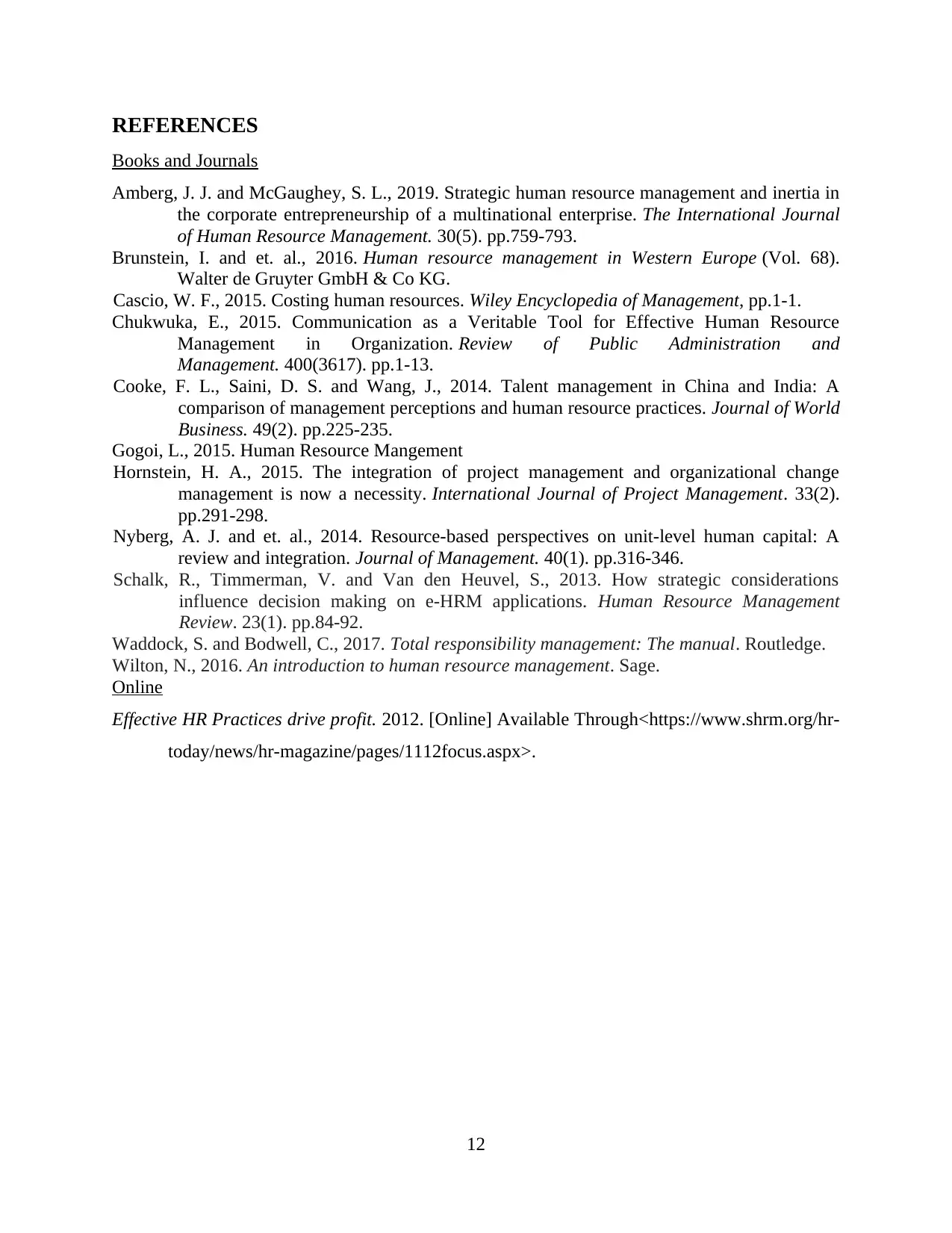
REFERENCES
Books and Journals
Amberg, J. J. and McGaughey, S. L., 2019. Strategic human resource management and inertia in
the corporate entrepreneurship of a multinational enterprise. The International Journal
of Human Resource Management. 30(5). pp.759-793.
Brunstein, I. and et. al., 2016. Human resource management in Western Europe (Vol. 68).
Walter de Gruyter GmbH & Co KG.
Cascio, W. F., 2015. Costing human resources. Wiley Encyclopedia of Management, pp.1-1.
Chukwuka, E., 2015. Communication as a Veritable Tool for Effective Human Resource
Management in Organization. Review of Public Administration and
Management. 400(3617). pp.1-13.
Cooke, F. L., Saini, D. S. and Wang, J., 2014. Talent management in China and India: A
comparison of management perceptions and human resource practices. Journal of World
Business. 49(2). pp.225-235.
Gogoi, L., 2015. Human Resource Mangement
Hornstein, H. A., 2015. The integration of project management and organizational change
management is now a necessity. International Journal of Project Management. 33(2).
pp.291-298.
Nyberg, A. J. and et. al., 2014. Resource-based perspectives on unit-level human capital: A
review and integration. Journal of Management. 40(1). pp.316-346.
Schalk, R., Timmerman, V. and Van den Heuvel, S., 2013. How strategic considerations
influence decision making on e-HRM applications. Human Resource Management
Review. 23(1). pp.84-92.
Waddock, S. and Bodwell, C., 2017. Total responsibility management: The manual. Routledge.
Wilton, N., 2016. An introduction to human resource management. Sage.
Online
Effective HR Practices drive profit. 2012. [Online] Available Through<https://www.shrm.org/hr-
today/news/hr-magazine/pages/1112focus.aspx>.
12
Books and Journals
Amberg, J. J. and McGaughey, S. L., 2019. Strategic human resource management and inertia in
the corporate entrepreneurship of a multinational enterprise. The International Journal
of Human Resource Management. 30(5). pp.759-793.
Brunstein, I. and et. al., 2016. Human resource management in Western Europe (Vol. 68).
Walter de Gruyter GmbH & Co KG.
Cascio, W. F., 2015. Costing human resources. Wiley Encyclopedia of Management, pp.1-1.
Chukwuka, E., 2015. Communication as a Veritable Tool for Effective Human Resource
Management in Organization. Review of Public Administration and
Management. 400(3617). pp.1-13.
Cooke, F. L., Saini, D. S. and Wang, J., 2014. Talent management in China and India: A
comparison of management perceptions and human resource practices. Journal of World
Business. 49(2). pp.225-235.
Gogoi, L., 2015. Human Resource Mangement
Hornstein, H. A., 2015. The integration of project management and organizational change
management is now a necessity. International Journal of Project Management. 33(2).
pp.291-298.
Nyberg, A. J. and et. al., 2014. Resource-based perspectives on unit-level human capital: A
review and integration. Journal of Management. 40(1). pp.316-346.
Schalk, R., Timmerman, V. and Van den Heuvel, S., 2013. How strategic considerations
influence decision making on e-HRM applications. Human Resource Management
Review. 23(1). pp.84-92.
Waddock, S. and Bodwell, C., 2017. Total responsibility management: The manual. Routledge.
Wilton, N., 2016. An introduction to human resource management. Sage.
Online
Effective HR Practices drive profit. 2012. [Online] Available Through<https://www.shrm.org/hr-
today/news/hr-magazine/pages/1112focus.aspx>.
12
⊘ This is a preview!⊘
Do you want full access?
Subscribe today to unlock all pages.

Trusted by 1+ million students worldwide
1 out of 12
Related Documents
Your All-in-One AI-Powered Toolkit for Academic Success.
+13062052269
info@desklib.com
Available 24*7 on WhatsApp / Email
![[object Object]](/_next/static/media/star-bottom.7253800d.svg)
Unlock your academic potential
Copyright © 2020–2025 A2Z Services. All Rights Reserved. Developed and managed by ZUCOL.





